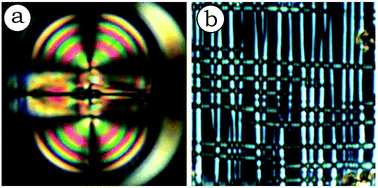Instabilities in the electric Freedericksz state of the twist-bend nematic liquid crystal CB7CB†
Abstract
We report on the instabilities in the Freedericksz state of the twist-bend nematic (NTB) liquid crystal 1′′,7′′-bis(4-cyanobiphenyl-4′-yl)heptane (CB7CB). The quasi homeotropic NTB state, into which a planar (untwisted or 90°-twisted) nematic CB7CB layer transits under a strong electric field, is found to be unstable despite the material being dielectrically positive. Close to the NTB melting point, destabilization occurs through the formation of metastable toric focal conic domains (TFCDs) that, in time, transform into parabolic focal conic domains (PFCDs) with the confocal parabolae in vertical planes through the layer normal. This transformation occurs by a novel process of continued dissociation of TFCDs. We outline how the extended Volterra process could help in a general appreciation of focal conic defects in the NTB phase. At relatively lower temperatures, stripes develop competingly with TFCDs. Identifiable as oily streaks, they are both localized and polarity sensitive; they form close to the substrates; and in low frequency square wave fields, they get suppressed at the cathode and augmented at the anode at each polarity switch. The study also dwells on the N–NTB–N sandwich region, found between the N and NTB states under a small temperature gradient.



 Please wait while we load your content...
Please wait while we load your content...